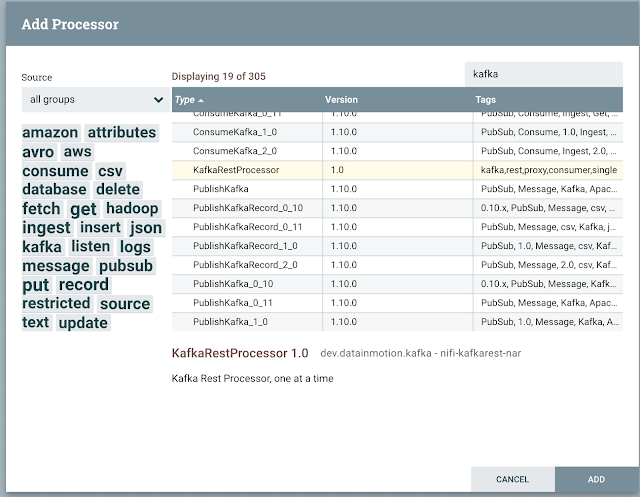Build and Utilizing The Apache NiFi - MiNiFi C++ Agent For Jetson Nano
(EdgeAI: Jetson Nano with MiNiFi C++ Agent)
source.hostname
jetsonnano
jetsonnano
source.ipv4
192.168.1.217
GetUSBCamera
FPS: .5
Bootstrap and Build
/opt/demo/nifi-minifi-cpp-source/build
bootstrap.sh
Options: Kafka, OpenCV, TensorFlow, USB Camera
Options: Kafka, OpenCV, TensorFlow, USB Camera
****************************************
Select MiNiFi C++ Features to toggle.
****************************************
A. Persistent Repositories .....Enabled
B. Lib Curl Features ...........Enabled
C. Lib Archive Features ........Enabled
D. Execute Script support ......Enabled
E. Expression Language support .Enabled
F. Kafka support ...............Enabled
G. PCAP support ................Disabled
H. USB Camera support ..........Enabled
I. GPS support .................Disabled
J. TensorFlow Support ..........Disabled
K. Bustache Support ............Disabled
L. MQTT Support ................Enabled
M. SQLite Support ..............Disabled
N. Python Support ..............Enabled
O. COAP Support ................Enabled
S. SFTP Support ................Enabled
V. AWS Support .................Disabled
T. OpenCV Support ..............Enabled
U. OPC-UA Support...............Enabled
****************************************
sudo apt-get install libcurl-dev libcurl4-openssl-dev -y
make
We can see when data arrives in NiFi from a MiNiFi Agent.
If CEM/Edge Flow Manager is a mystery to you, check out the live Swagger REST Documentation.
With MiNiFi C++ I can add a USB Camera.
Example Data
{"uuid": "nano_uuid_crr_20200218002610", "ipaddress": "192.168.1.217", "top1pct": 54.833984375, "top1": "cab, hack, taxi, taxicab", "cputemp": "45.5", "gputemp": "43.5", "gputempf": "110", "cputempf": "114", "runtime": "4", "host": "jetsonnano", "filename": "/opt/demo/images/image_esq_20200218002610.jpg", "imageinput": "/opt/demo/images/2020-02-17_1926.jpg", "host_name": "jetsonnano", "macaddress": "ec:08:6b:18:0d:7f", "end": "1581985574.6246474", "te": "4.158604383468628", "systemtime": "02/17/2020 19:26:14", "cpu": 51.8, "diskusage": "5479.7 MB", "memory": 71.4, "id": "20200218002610_8a12dd65-1038-41ac-b923-98fc907f5be0"}
Example Config.yml Section
name: AppendHostInfo
class: org.apache.nifi.minifi.processors.AppendHostInfo
max concurrent tasks: 1
scheduling strategy: TIMER_DRIVEN
scheduling period: 1000 ms
penalization period: 30000 ms
yield period: 1000 ms
run duration nanos: 0
auto-terminated relationships list: []
Properties:
Hostname Attribute: source.hostname
IP Attribute: source.ipv4
Network Interface Name: wlan0
Example Output
[2020-02-11 19:35:09.116] [org::apache::nifi::minifi::processors::ExecuteProcess] [info] Execute Command /opt/demo/rundemo.sh[2020-02-11 19:35:11.275] [org::apache::nifi::minifi::c2::C2Agent] [info] Checking 0 triggers[2020-02-11 19:35:13.742] [org::apache::nifi::minifi::c2::C2Agent] [info] Checking 0 triggers[2020-02-11 19:35:15.568] [org::apache::nifi::minifi::core::ProcessSession] [info] Transferring 899b5964-4d2f-11ea-8b9a-6e260e221e3d from ExecuteProcess - Python to relationship success[2020-02-11 19:35:15.568] [org::apache::nifi::minifi::processors::ExecuteProcess] [info] Execute Command Complete /opt/demo/rundemo.sh status 0 pid 31004[2020-02-11 19:35:15.569] [org::apache::nifi::minifi::core::ProcessSession] [info] Transferring 899b5964-4d2f-11ea-8b9a-6e260e221e3d from AppendHostInfo to relationship success[2020-02-11 19:35:15.649] [org::apache::nifi::minifi::sitetosite::SiteToSiteClient] [info] Site to Site transaction 4d0b460e-e4f6-4ca1-8c56-30d310a0712b sent flow 1flow records, with total size 3581[2020-02-11 19:35:15.785] [org::apache::nifi::minifi::sitetosite::HttpSiteToSiteClient] [info] Site to Site closed transaction 4d0b460e-e4f6-4ca1-8c56-30d310a0712b[2020-02-11 19:35:15.841] [org::apache::nifi::minifi::sitetosite::SiteToSiteClient] [info] Site2Site transaction 4d0b460e-e4f6-4ca1-8c56-30d310a0712b peer finished transaction[2020-02-11 19:35:15.841] [org::apache::nifi::minifi::io::HttpStream] [warning] Future status already cleared for http://ec2-35-171-154-174.compute-1.amazonaws.com:8080/nifi-api/data-transfer/input-ports/17979d5f-0170-1000-0000-000011f1cc00/transactions/4d0b460e-e4f6-4ca1-8c56-30d310a0712b/flow-files, continuing[2020-02-11 19:35:16.236] [org::apache::nifi::minifi::c2::C2Agent] [info] Checking 0 triggers[2020-02-11 19:35:16.263] [org::apache::nifi::minifi::core::ProcessSession] [info] Transferring 8a05413a-4d2f-11ea-8b9a-6e260e221e3d from TailFile to relationship success[2020-02-11 19:35:16.264] [org::apache::nifi::minifi::processors::TailFile] [info] TailFile nano.log for 616 bytes[2020-02-11 19:35:16.273] [org::apache::nifi::minifi::core::ProcessSession] [info] Transferring 8a05413a-4d2f-11ea-8b9a-6e260e221e3d from AppendHostInfo to relationship success[2020-02-11 19:35:16.274] [org::apache::nifi::minifi::core::ProcessSession] [info] Transferring 8a05413a-4d2f-11ea-8b9a-6e260e221e3d from PublishKafka to relationship success[2020-02-11 19:35:18.748] [org::apache::nifi::minifi::c2::C2Agent] [info] Checking 0 triggers[2020-02-11 19:35:21.260] [org::apache::nifi::minifi::c2::C2Agent] [info] Checking 0 triggers
Using Apache NiFi - MiNiFi C++ Agent Elsewhere
I am working on a Jetbot robot powered by NVidia Jetson Nano that will use the MiNiFi C++ agent.








































































